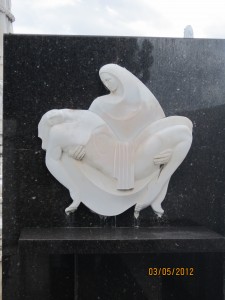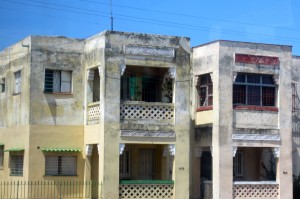Art Deco in Havana
May 4, 2012 by sptilger
My first day in Havana I was convinced I had found the most beautiful building I had ever seen. Five minutes later I found a new building more beautiful than the last. And so on for two weeks. The city is magnificent in the sheer number of historical buildings that still exist there, which range from colonial-era churches to hotels built by American mobsters up until the Revolution. The buildings that in particularly captured my fascination were the stunning art deco structures that dot the entirety of the city, from the Bacardi building right outside our hotel in Habana Vieja, to residential homes in Vedado and Miramar.
Art deco is perhaps the definitive style of the period between WWI and WWII. It emerged in Paris, but quickly spread to the US and beyond, manifesting in every facet of visual life, influencing things as small as typography, and as large as buildings, the focus of this post. The name Art Deco derives from the French term Arts Décoratifs, referring to deco as for the most part a purely aesthetic movement; its only political statement its self-conscious modernity in the Machine Age (Unger, VIII). In Cuba, Batista used Monumental Modern, an offshoot of deco, as a political statement, commissioning many large-scale projects in the style as a demonstration of his modernity and power (Unger, XII).
Deco was an international movement, but took on characteristics unique to each location in which it manifested. In his book Havana Deco David Unger describes Cuban deco as having a “sultrier” tropical flair, with palm trees and Afro-Cuban influences permeating the style (VI). Deco arrived in Cuba in 1927 (Unger, XI), and reached high recognition in 1930 with the completion of the Bacardi building, Havana’s tallest structure at the time. Unger attributes Havana’s impressive examples of the style as a result of the skill of Cuba’s architects and technicians, as well as the island’s unique position as a crossroads and its historical ability to “assimilate” and blend (X, 3-4).
Common deco elements seen in Havana include decorative frieze panels cast in cement, geometric ornamental borders, and ironwork. Friezes give Havana deco design continuity through their high presence in the city. From “modest dwellings” to upper class developments, friezes were incorporated into most new construction of the era. Deco touches could be massed produced in keeping with its modernist roots or designed for the individual structure, which gives the style an adaptability that helps explain its wide use in the city (Unger, 39).
The biggest issue facing these buildings is the lack of money to preserve them. “Saving architecture seems like a luxury in today’s Cuba,” one article states (McGuigan). The internationally recognized monuments like the Bacardi building are in no danger of being lost, but the many smaller gems around Havana are suffering from the same lack of funds that has caused much of the city to be crumbling. The Office of the City Historian of Havana has a mandate to take tourism money and put it into restoration of Habana Vieja, but architecture from after the colonial period has not been prioritized. Due to tourism the funding is slowly appearing, and provided the preservation process continues as it has, the issue facing Havana will be ensuring that restored buildings are still functional, that the city is not rendered simply a “theme park” for tourists (McGuigan, 52-5).
Finally, it is important to remember that though Cuba’s economic straights are to blame for the crumbling nature of Havana’s buildings, without the Revolution many of these structures would have been lost years ago. Urban renewal and other development schemes destroyed many similarly aging structures around the world, and one scholar argues that “only because of the Cuban Revolution was Havana spared the disfiguring demolitions and reconstructions of other Latin American cities,” (“Saving Havana”, 2000). Just as the Special Period produced an ecological “accidental Eden” in Cuba, it seems the Revolution has done the same for architecture.

Unger mentions that some of the “most stunning” examples of deco can be seen in the Colon cemetery (VI). I was especially taken by the deco Piedad by Rita Longa, which is the centerpiece of the Aguilera Family’s vault. Photo by Nikola Alexandre
Bibliography
Alonso, Alejandro. Havana Deco. 1st American ed. New York: Norton & Company, 2007. Print.
“Editors Corner: Saving Havana.” Cuba Update Jun 30 2000: 1-. Alt-PressWatch. Web. 2 May 2012 .
McGuigan, Cathleen. “Saving Havana.” Newsweek Jul 15 2002: 52-5. ABI/INFORM Complete; ProQuest Research Library. Web. 2 May 2012 .
Leave a Reply
You must be logged in to post a comment.



